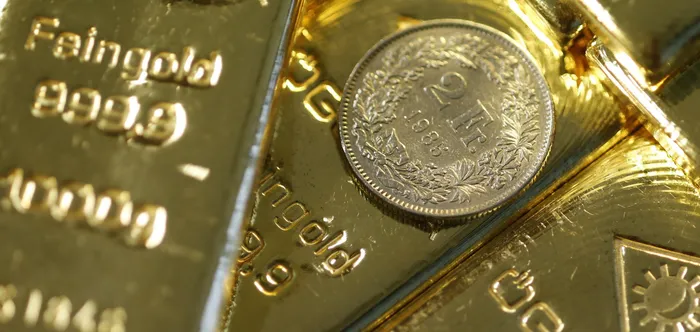Uncertainty about US stagflation good for the Rand, gold, and the All Share index - Chris Harmse
MONDAY MARKETS

In reaction to the uncertainty on the US economy, the gold price recorded almost a new record level daily. Bullion closed on Friday at $3 779 per ounce, $97 per once higher for the week.
Image: Reuters
The dichotomy between US unemployment and inflation, baptised as a process of stagflation, continues to shift investments to Gold, Platinum and other haven assets. Together with this sentiment of further rate cuts by the US Federal Reserve, the decision by the Reserve Bank’s Monetary Policy Committee not to lower the repo rate the previous week, pushed real rates between the US and South Africa to unique highs.
This causes portfolio capital inflow and the Rand/dollar exchange rate to trade at its strongest level since September 26, 2024. The currency last Tuesday in intra-day trade reached $17.22 against the dollar. Although the Rand ended Friday sideways at R17.34/$, the same level as the previous week, it is still 150 cents stronger than at the beginning of the year (R18/84/$). Against the Euro the Rand improved by 10c last week to R20/28 €, trading still 100c weaker than at the beginning of the year (R19.20/€). Against the UK Pound the Rand also improved slowly, trading stronger at 20c at R23.25/£, the same level as at the beginning of the year.
In reaction to the uncertainty on the US economy, the gold price recorded almost a new record level daily. Bullion closed on Friday at $3 779 per ounce, $97 per once higher for the week. This is $1 135 up from the beginning of the year. Some market analysts are now forecasting that the gold price may test the $5 000 level over the next year. The Platinum price also shot up by $172 per ounce last week to close Friday on $1 588. This is $675 per ounce, or 72% up for the year-to-date.
On the equity market the bull run continues. Although share prices on the JSE contracted somewhat during the middle of last week, the All Share index pushed to a new record level on Friday, trading at one stage at 106 894 points to close at a record daily level of 106 700 points. This is 0.8% up for the week and a sixth consecutive week increase to record levels. The All Share index is up by 26.5% for the year-to-date. The prices for precious metals contributed much to the increase of more than 106% in the RES10 index since the beginning of the year.
Further US interest rate cuts reinforced
Data from the US Commerce department released on Friday showed that the US Personal Consumption Expenditures (PCE) price index rose 2.7% year-on-year in August. This contributed to US headline inflation remaining at 2.9%, and well above the Fed target of 2.0%. These data were in line with economists’ expectations in a Reuters poll. Expectations rose to an 88% probability of a rate cut in October and a 65% chance of another in December, according to the CME FedWatch Tool.
On Wall Street equities the Dow Jones Industrial index closed Friday up by 0.65%, ending the week flat losing -0.15%. The S&P500 index also ended Friday strongly, gaining 0.6% but losing -0.3% over the week. Analysts still are from the viewpoint that given the expected increase in unemployment and the effect of tariffs on the consumer will eventually lead to a downward correction in US share prices in months to come.
Prospects for this coming week
South Africa awaits the release of the central government budget balance on Tuesday. It is expected that the deficit narrowed strongly to -R45 billion in August, down from -R125 billion in July. New vehicle sales for September will be announced on Wednesday, expecting to have increased marginally to 52 000, up from 51 800 in August.
On global markets the release of the US non-farm payrolls for September will not only set the tone for financial markets in weeks to come but will directly bear on the next Federal decision on interest rates at their next meeting in October. It is expected that the US economy will create 39 000 new jobs, against the 22 000 in August and that the unemployment rate remains steady at 4.3%. If this data is worse, then the possibility of a next interest rate cut by the Fed becomes a certainty.

Chris Harmse is the consulting economist of Sequoia Capital Management and a senior lecturer at Stadio Higher Education.
Image: Supplied
Chris Harmse is the consulting economist of Sequoia Capital Management and a senior lecturer at Stadio Higher Education.
*** The views expressed here do not necessarily represent those of Independent Media or IOL.
BUSINESS REPORT